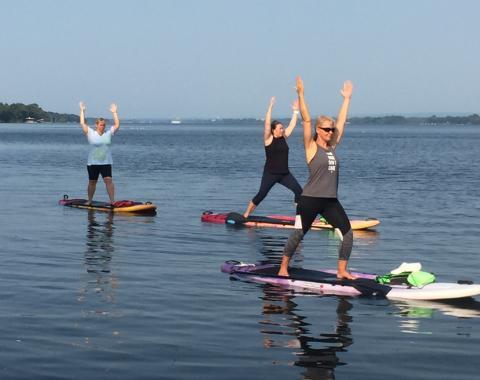
Stand Up Paddle Boarding is growing in popularity. If you enjoy being on water, this activity provides an opportunity to have a close up appreciation of aquatic life, as you navigate a body of water. You will also benefit from a physical work out as you paddle and surf. Your balance will be tested and enhanced practising various yoga poses on your floating board. SUP engages one in fitness while providing pleasure, relaxation and fun!
History
SUP is a surface water sport, a variant of surfing but using a paddle to move through the water while standing on a surfboard. Derived from Polynesian roots, the Hawaiian Ku Hoe He’e Nalu; translates to “stand, to paddle, to surf a wave.”
One difference between the modern idea of surfing and SUP is that the latter does not necessarily need a wave: one can paddle on the open ocean, in harbours, on lakes, rivers or any large body of water. An advantage is the angle of visibility, standing higher over the water, one can see both deeper into in to it and further across. This allows for greater awareness of one’s surroundings, whether it is marine life in or incoming swells.
Water Safety
Know the rules locally.
Stand up Paddle boards are considered to be vessels and in our area, require a Personal Floatation Device strapped to your board.
Boat Rules.
If you are converging with a boat head on, veer to the right, if you are about to cross a boat at a 90 degree angle, always cross behind the boat, never in front. The left side of the boat is called port and it is lit red at night, the right side is called starboard and it is lit green at night.
A boat has to stay in between red and green buoy markers. “Red Right Return” means when a boat returns from sea to the marina, the red buoy needs to be on the right-hand side.
Stand Up Paddleboard Safety
This is the most important part about Stand Up Paddle Boarding! Since this sport is relatively easy to pick up, sometimes water safety can be overlooked. It is essential to have an understanding of the risks, before heading out. Here is a list of important water safety tips to follow in all bodies of water.
*Always try to paddle with a friend.
*You should always be wearing a Personal Flotation Device and leash.
*It is always best to begin in calm flat water and build up strength and confidence before venturing into an ocean, river or rough surf.
*Always be aware of the weather conditions, especially the wind! Try to paddle into the wind first, so you will not be as tired on the way back.
*If you are having difficulty paddling in the wind, go down to your knees for easier balance and less wind resistance. Draw both hands to the middle of the paddle, for a more efficient stroke.
*Practice a safe wipe out by falling to the left or right side of the board. Please avoid falling backwards. If you feel yourself falling backwards, try and run off the back of the board to avoid hitting your head on the board.
*If you fall in, get back to your board as quickly as possible. The wind can push the board away from you. Don’t worry about the paddle, you can always get it later since they float.
*Pull yourself back onto your board by reaching across the deck to the opposite rail, pulling yourself up, and then start paddling from a kneeling position until you resume your momentum.
Apparel
What to wear depends on the weather conditions. If it is hot, a bathing suit will be fine, if it’s cold, you may want to wear a wet suit. For SUP Yoga, the most common clothing is a bathing suit underneath yoga clothing.
Eye wear and a hat are recommended for sun protection. If you are new to paddle boarding, you may want to wear a pair of sun glasses you don’t mind losing, just in case you fall in. A trucker hat is best because it floats. Make sure to wear sunscreen!
Boards
There are many different types of boards, race boards, surf boards, white water boards, downwind boards; all parts of these boards are basically the same. The front is the nose, the back is the tail, the sides are the rails, the top is the deck, and underneath the board are the fins. Choosing a paddleboard depends on what you will be using it for, what your budget is, how much you weigh, and your ability. Contact your local shop to demo boards or ask a certified instructor.
An all-around board is the most popular style, these are great if you are a beginner or want to do a little bit of everything. We love this style of board at Floating Lotus and use them in all of our classes. They are great boards for touring, fitness, surfing, and Yoga.
Ready to SUP
When you have chosen your board, paddle and safety equipment, you are ready for the water. It is always best to learn from a certified instructor as there are many safety tips and paddling techniques that will enhance your experience. If you are looking to learn SUP through private sessions or group classes, our Floating Lotus SUP girls would love to help you out. You can find us at www.mindfulmovements.ca
Amber Irwin and Kym Riley both Certified Paddle into Fitness Instructors



